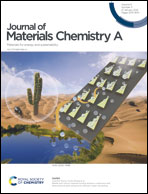A DNA-inspired hydrogel mechanoreceptor with skin-like mechanical behavior†
Abstract
Skin-mimicking electronics have aroused extensive interest in personalized health monitoring, human movement detections, and biomedical implants. However, the existing flexible electronics are still unable to compare with the advanced performance of human skin, and it remains challenging to achieve a high skin-mimicking capability. Herein, we design a DNA-inspired hydrogel mechanoreceptor with skin-like perception and mechanical behavior, as well as excellent biocompatibility. The hydrogels are constructed using a DNA-inspired adenosine monophosphate crosslinked quaternized chitosan network and a NaCl-containing polyacrylamide network. The hydrogels possess a low modulus, high toughness, self-stiffness, and fast self-recovery. As a result, the hydrogel mechanoreceptors exhibit high sensitivity toward strain and pressure, and present negligible electromechanical hysteresis even at a big deformation (strain of 500%). Impressively, the hydrogels can function as reliable wearable sensors for detecting whole-body movements and physiological signals, including various joint motions, facial emotions, vocalization, and respiration. It is anticipated that the DNA-inspired hydrogel mechanoreceptors would fuel the development of new generation of flexible electronics, such as electronic skin, medical implants, soft robotics, and flexible touchpads.



 Please wait while we load your content...
Please wait while we load your content...